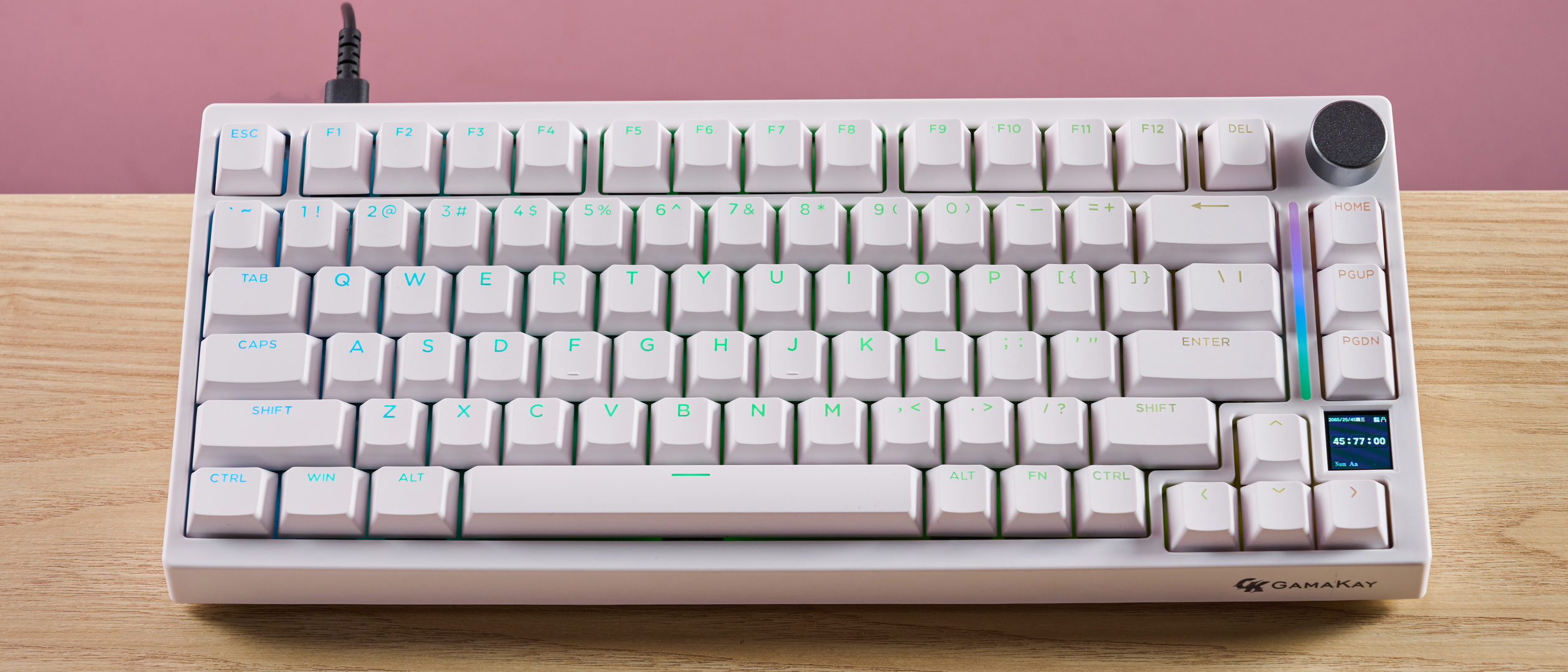TechRadar Verdict
The Gamakay TK75HE V2 has great analog performance with excellent tweaking potential, courtesy of the accompanying software. However, this software does have a few usability issues, and typing with the board can get uncomfortable quickly, thanks to the lack of wrist support. Still, at this price, you’ll struggle to find many keyboards with Hall effect analog tech as good as this.
Pros
- +
Well-priced
- +
Capable and satisfying performance
- +
Useful analog adjustments
Cons
- -
Usability issues with software
- -
Limited integrated display
- -
Needs wrist support
Why you can trust TechRadar
Gamakay TK75HE V2: two-minute review
The Gamakay TK75HE V2 is a wired keyboard with Hall effect analog switches that provide snappy and precise inputs, and feature multiple actuation adjustments to tailor key response to your exact preferences.
It sports a minimal aesthetic, which, combined with its compact form, makes it conducive to use in any setting. This aspect is somewhat hampered, however, by the short USB cable, which might fail to reach your PC depending on your setup.
Still, the overall build quality of the TK75HE V2 is impressive, on a level-pegging with some of the best gaming keyboards. The plastic chassis is light yet reassuringly solid, and, although it’s thick at the rear, this tapers off towards the front. The PBT keycaps feel as premium as you could wish for, too.
The two-stage folding feet provide plenty of tilt for getting an ergonomic typing position, although I still found the TK75HE V2 uncomfortable to type with for extended periods, owing to the lack of wrist support needed to offset its elevated height.
A screen is integrated in the bottom right corner of the TK75HE V2, although this is very limited in scope, with actuation adjustments, for instance, missing from its menu. For settings such as these, you’ll need to use the Gamakay Driver.
This PC app allows you make all the usual keyboard customizations, with various rebind options available, alongside macro creation and RGB adjustments. Tweaks for the analog switches are plentiful and accompanied by a handy visualizer to see key response in real time.
However, this visualizer lacks some useful feedback indicators, and has a tendency to lag significantly when making multiple inputs rapidly. What’s more, the app window can’t be resized, and a few explanations lack clarity, while others were cut off from the GUI, which was frustrating.
Sign up for breaking news, reviews, opinion, top tech deals, and more.
Thankfully, the tool is usable enough, and the analog adjustments it can make provide a meaningful difference to performance. To game with, the TK75HE V2 is certainly responsive, although I can’t say its 8K polling rate makes much difference in this regard, relative to lower-polling keyboards.
Key presses with the linear Mercury switches installed on my TK75HE V2 were less damped than I was expecting – certainly less so than the ultra-soft tactile Pegasus switches I tried in the mechanical TK75 V2, for instance – but I still found them satisfying to use, whether I was gaming or typing.
The latter was also helped by the shallow, short-traveling Cherry profile keycaps, which makes the TK75HE V2 suited to productivity tasks. However, it really needs a wrist rest to make long sessions comfortable.
The TK75HE V2 has a low price for an analog keyboard, undercutting many of its big name rivals by a huge margin, such as the SteelSeries Apex Pro. However, that keyboard has some of the best analog switches I’ve tried, and offers exceptional gaming performance overall.
But the TK75HE V2 isn’t that far behind in this regard, which makes it a great entry point for those looking to get their fingers on some analog switches. The mechanical TK75 V2 is slightly cheaper but not by much, although this would be a better alternative for those who prefer soft and silent key presses.
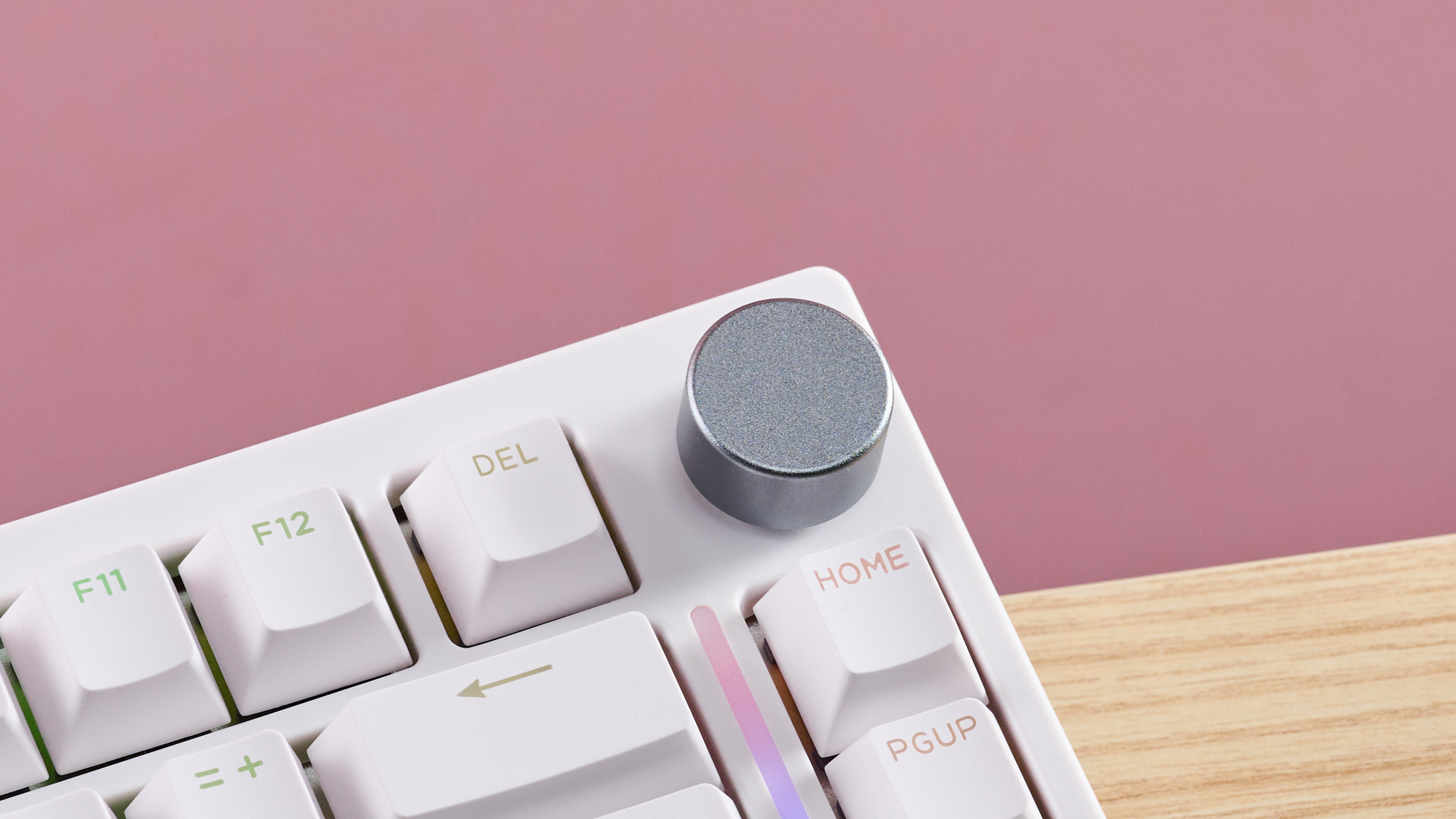
Gamakay TK75HE V2 review: price and availability
- $109.99 / £85 / AU$176
- Available now in two colorways
- Cheaper than many analog boards
The TK75HE V2 costs $109.99 / £85 / AU$176 and is available now in two colorways: black and white. It can be configured with two stock switch types: Phoenix, which is silent; or Mercury, which is linear. Additionally, it comes with a USB cable and a keycap puller for hot-swapping purposes.
The TK75HE V2 is more expensive than its mechanical counterpart, the TK75 V2, which has an exquisite typing feel with much more dampening, although this could be due to the tactile Pegasus switches I experienced in that board. However, since it doesn’t use analog switches, there aren’t any actuation adjustments.
If you’re looking for pure analog performance, the SteelSeries Apex Pro TKL is hard to beat. It’s one of the best keyboards with analog switches in my view, offering incredible precision and responsiveness, but it’s considerably more expensive than the TK75HE V2.
Value score: 5 / 5
Gamakay TK75HE V2 review: specs
Layout | 75% |
Switch | Analog (Hall-effect magnetic) |
Programmable keys | Yes |
Dimensions | 12.8 x 5.4 x 1.1 inches / 325 x 136 x 28mm |
RGB or backlighting | Yes (customizable) |
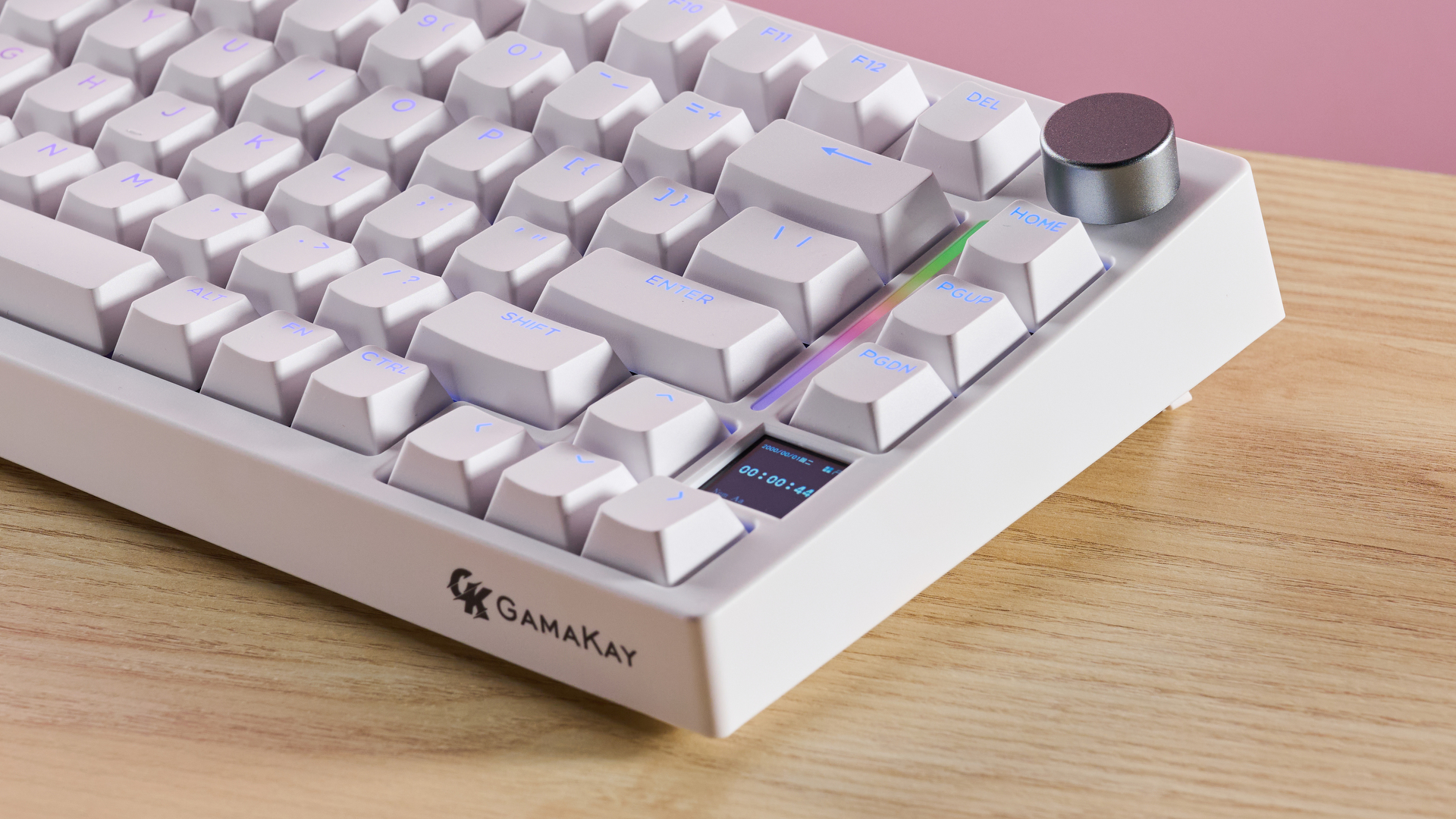
Gamakay TK75HE V2 review: design and features
- Minimal looks
- Premium feel
- Versatile but unrefined software
The TK75HE V2 has a rather understated appearance, although this is buoyed somewhat by the bright RGB lighting, which is even more pronounced in the white variant. But overall its minimal aesthetic should fit in well with most setups.
Build quality is also admirable, with the plastic chassis feeling durable yet pleasingly light at the same time. It has a thick depth at the back, but this narrows out at the front, which helps to keep things compact.
This narrowing also improves usability, since the TK75HE V2 doesn’t come with a wrist rest. It does come with a USB cable, but this is disappointingly short and may prove unfeasible for certain setups.
The PBT keycaps feel premium to the touch, with a very subtle texture that doesn’t encroach on their smoothness. It’s slightly inconvenient, however, that the FN shortcuts aren’t labelled on the keys themselves, so you’ll have to refer to the included manual to see what they are.
The volume wheel is well notched to allow for smooth yet controlled jogging, although its click function is a little too stiff for my liking – but this is a minor grievance.
A small screen is also nestled in the bottom right corner, controllable via the volume knob, although I found little use for it since its functionality is quite limited. You can view the runtime and date, as well as CPU usage and temperature – although these latter two failed to take readings, and there’s nothing in the manual to explain how to set this up.
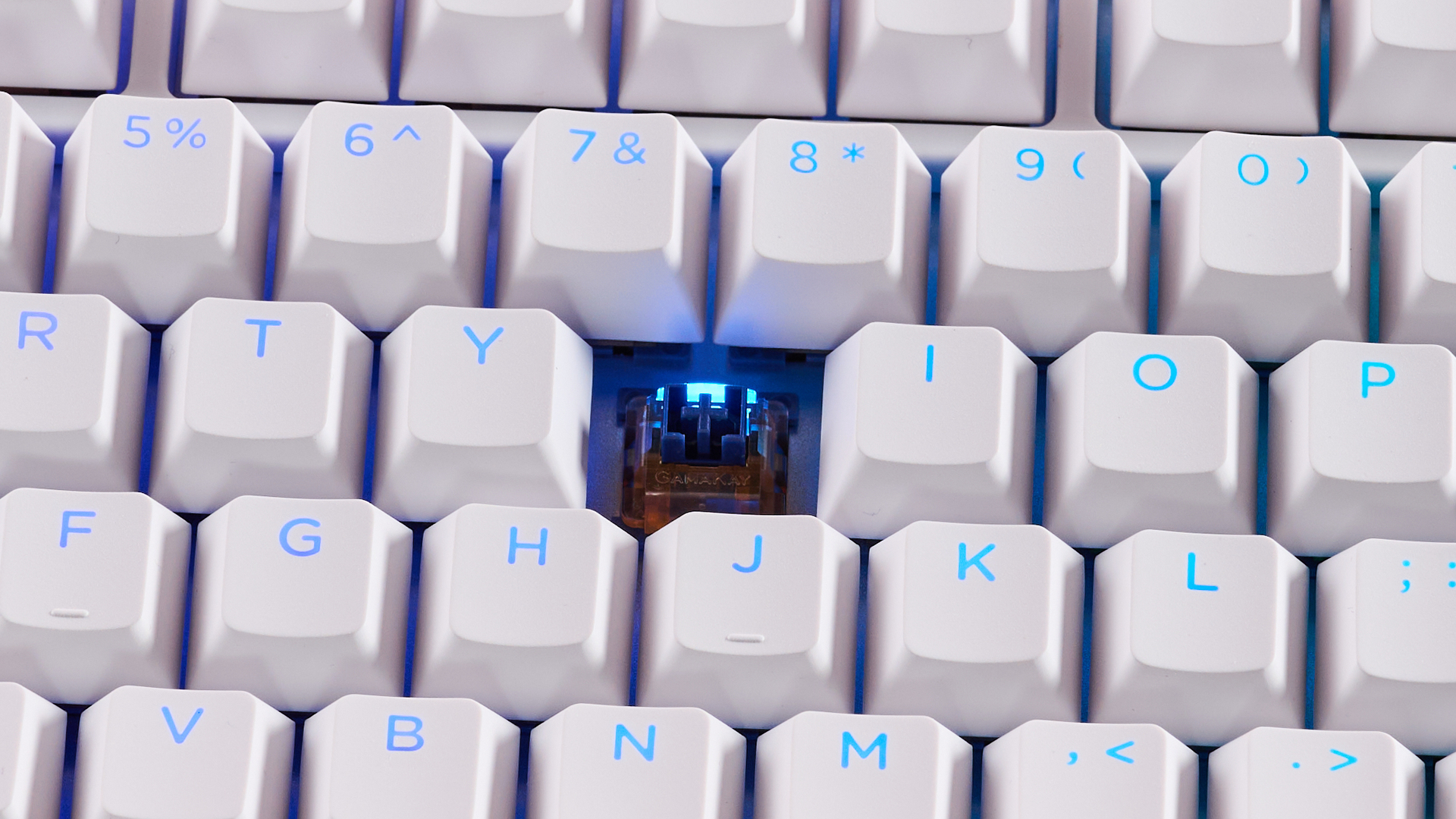
Rounding out the interface’s capabilities are RGB lighting adjustments and Mac and Windows modes. You can also display your own drawings, but for this you’ll need to download the Gamakay Driver PC app.
This app also contains many other typical gaming keyboard customizations. There are various rebinding options with multiple layers available, although sadly system shortcuts and commands seem to be absent: you can only remap keys to other keys, key combinations with modifiers, or macros you’ve created.
There are also numerous adjustments for the analog switches, though, including independent actuation point sliders for presses and releases. There are also various modes to toggle and configure, such as multi-input, continuous trigger, and others.
Overall, the Gamakay Driver provides an impressive selection of customizations, although some analog-based functions are missing, such as controller emulation. What’s more, the software isn’t without its faults.
Firstly, the app window can’t be resized, which, in my experience at least, can result in cut-offs. There were also certain sections where text explanations weren’t fully rendered.
What’s more, certain explanations were hard to understand, and some occasional odd word choices didn’t help matters either: for example, a button used to select multiple keys for customizing simultaneously is labelled “drag”.
Design & features score: 3.5 / 5
Gamakay TK75HE V2 review: performance
- Satisfying feedback
- Not as damped as other keyboards
- Controlled analog switches
The TK75HE V2 is very capable when it comes to gaming. Its keys are very responsive, although I can’t say the 8K polling rate provided a noticeable improvement in this regard over other boards.
The unit I had came preinstalled with Gamakay’s Mercury switches, which are said to have a linear profile. Their impact might deter some gamers, as they lack the dampening of some of the best mechanical keyboards: they’re more clicky and louder, but there’s still enough cushioning to make them satisfying to use.
What’s more, they feel a little heavier than other analog switches I’ve tried, which works in their favor as their resistance is progressive, feeling lighter at the top but getting heavier as they near the end of their travel.
This makes for controlled presses, and is especially useful when trying to hit certain actuation points. It also means that quickfire presses are easy to execute, which is especially useful when using the Rapid Tap feature – one of the key selling points of analog switches.
The mild indentation of the Cherry profile keys was something I welcomed too, as they allow for a secure positioning while still being amenable to gliding over the board.
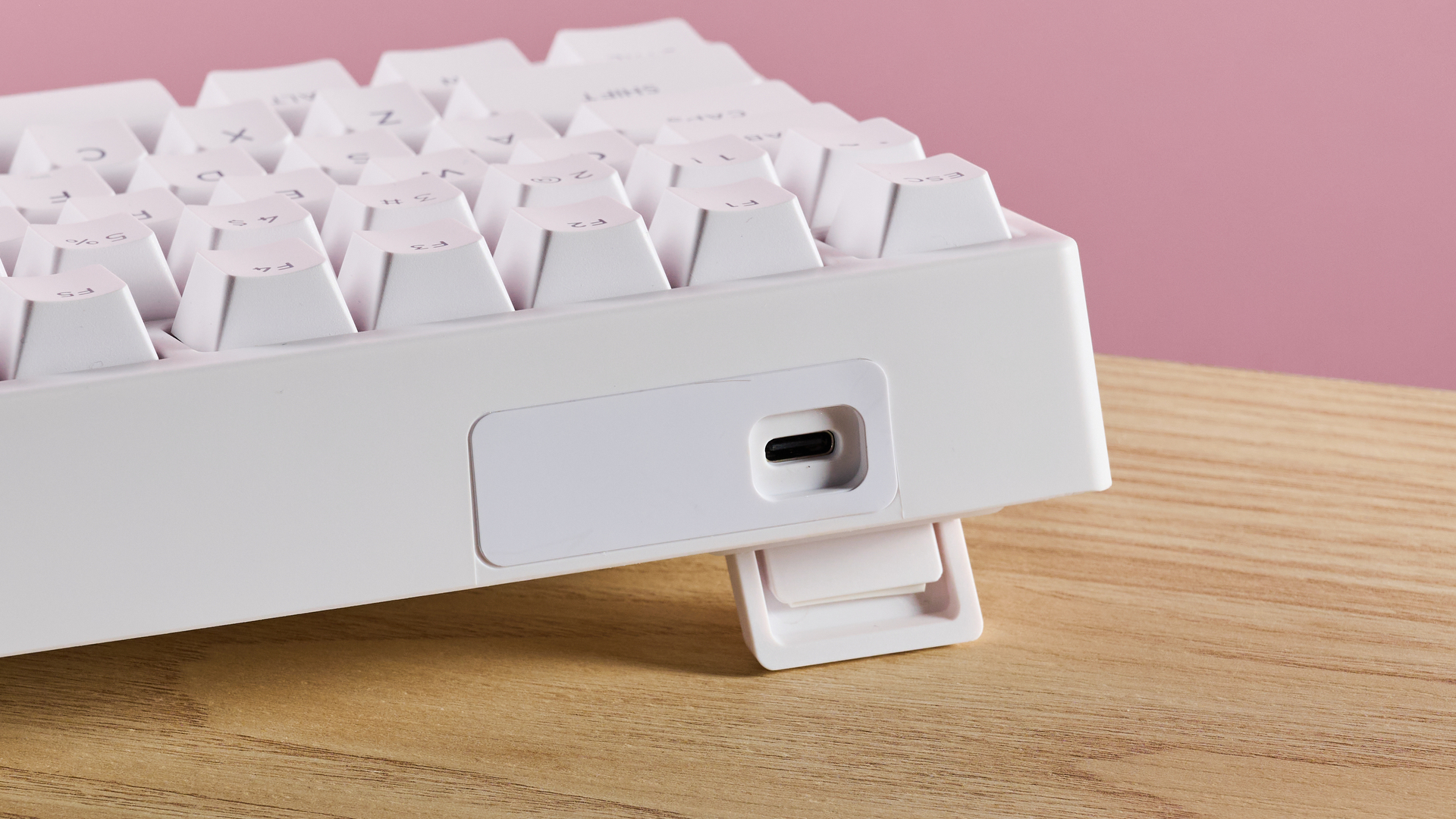
This aspect also makes the bottom row readily accessible, as does the subtle concaving of the layout in general. The space bar is pleasingly low too, as it meant I could hit it with the tip of my thumb rather than the edge.
However, one small gripe I have is with the feet, which aren’t stable enough to handle even small shuffles back and forth. This may prove frustrating to those who frequently adjust the position of their keyboard.
Typing performance is also good, with those Mercury switches providing plenty of feedback and bounce, while being controlled at the same time. This allowed for fast and accurate typing – although the drawback is the relatively loud noise they generate.
I found the layout a little cramped at first, but I got used to it quickly. The angle provided by the feet does improve the ergonomics, but I still experienced some discomfort after only a short period; the TK75HE V2 is another keyboard that requires additional wrist support and yet sadly doesn't come with any.
Performance score: 4 / 5
Should I buy the Gamakay TK75HE V2?
Attributes | Notes | Rating |
|---|---|---|
Value | You’ll struggle to find many analog keyboards cheaper than this, and its performance and build are impressive for price. | 5 / 5 |
Design and features | The TK75HE V2 is minimal and inoffensive. It’s also well built, although the software, while versatile, isn’t as refined as others. | 3.5 / 5 |
Performance | The analog switches are certainly responsive, and it’s great for both gaming and typing – although wrist support is sorely needed. | 4 / 5 |
Overall | The TK75HE V2 is an impressive keyboard considering its relatively low price tag. The software provides useful customizations, although it’s not the best engineered. If you’re looking for a budget analog keyboard, this should certainly be a contender. | 4 / 5 |
Buy it if…
You want to hot-swap
You can choose which switches come equipped in your TK75HE V2, but if you ever fancy a change, you can swap them out at any time.
You want analog switches at a good price
There aren’t too many analog boards around at this price, and it doesn’t exactly feel as if you’re skimping on quality.
Don’t buy it if…
You want the best software
The Gamakay Driver has plenty to offer, but it’s not always the easiest to work with, thanks to some interface issues.
You want the best comfort
The feet offer a meaningful break angle that makes typing more comfortable, but the TK75HE V2 really needs a wrist rest if you plan on using it for productivity.
Gamakay TK75HE V2 review: also consider
| Header Cell - Column 0 | Gamakay TK75HE V2 | SteelSeries Apex Pro TKL Gen 3 | Gamakay TK75 V2 |
|---|---|---|---|
Layout | 75% | TKL | 75% |
Switch | Analog (Hall-effect magnetic) | Analog (Hall-effect magnetic) | Mechanical |
Programmable keys | Yes | Yes | Yes |
Dimensions | 12.8 x 5.4 x 1.1 inches / 325 x 136 x 28mm | 14.5 x 5.5 x 1.5 inches (approx.) / 368.3 x 139.7 x 38.1mm | 12.8 x 5.4 x 1.1 inches / 325 x 136 x 28mm |
RGB or backlighting | Yes (customizable) | Yes (customizable) | Yes (customizable) |
SteelSeries Apex Pro TKL Gen 3
The Apex Pro is certainly more expensive than the TK75HE V2, but its analog switches are a dream to use, and its adjustments and accompanying software are great as well. A wireless variant is also available, which is naturally even more expensive, but not by a huge margin. Read our full SteelSeries Apex Pro TKL Gen 3 review.
Gamakay TK75 V2
If you don’t need analog switches, then Gamakay makes for a great alternative. The tactile Pegasus mechanical switches I experienced in this board had much greater dampening and felt fantastic for both gaming or typing. It’s cheaper than the TK75HE V2 too, although not by much, but that’s fine since both are well-priced considering what they offer. Read our full Gamakay TK75 V2 review.
How I tested the Gamakay TK75HE V2
- Tested for a few days
- Used for gaming and working
- Plentiful keyboard experience
I tested the TK75HE V2 for a few days, during which time I used it for gaming and working on both Windows 10 and 11 machines.
I played Counter-Strike 2, which is a great test for any peripheral due the premium it places on fast and accurate inputs. It’s especially useful when testing analog switches, since counter-strafing can put Rapid Trigger features through their paces.
I have been PC gaming for over a decade, and during that time I have used a great deal of keyboards. I have also reviewed numerous examples, including those with analog switches and other Gamakay models.
- First reviewed: May 2025
- Read more about how we test

Lewis Maddison is a Reviews Writer for TechRadar. He previously worked as a Staff Writer for our business section, TechRadar Pro, where he gained experience with productivity-enhancing hardware, ranging from keyboards to standing desks. His area of expertise lies in computer peripherals and audio hardware, having spent over a decade exploring the murky depths of both PC building and music production. He also revels in picking up on the finest details and niggles that ultimately make a big difference to the user experience.
You must confirm your public display name before commenting
Please logout and then login again, you will then be prompted to enter your display name.
